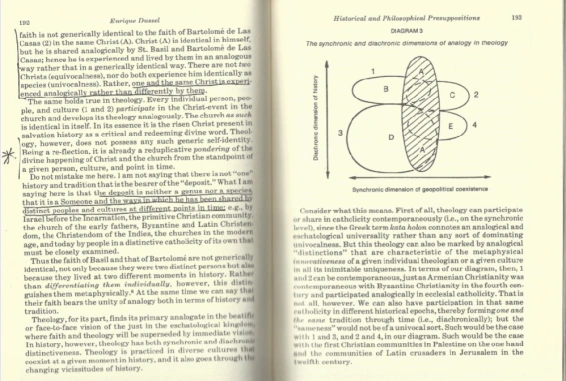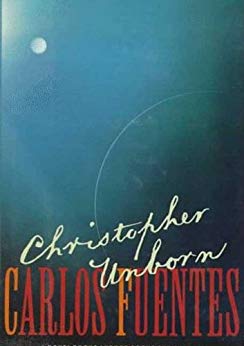
Curiously, this is the first result that appeared when I conducted an image search at DuckDuckGo for “The earth is round, like an orange.” As Kansans and other South Central U.S. people know, this is the fruit of the Osage orange tree, which goes by several other names depending on the region you find yourself in. The fruit is inedible, but the Indians in what is now Arkansas used its wood to make bows, and the first white settlers here planted rows of these trees to serve as windbreaks and fencelines. It seems strangely appropriate to me that a search for an image to accompany a post on the neo-Baroque in the New World would turn up this, an image of an indigenous plant whose surface is about as Baroque as you can get. Image found here.
Early in Gabriel García Márquez’s magnificent novel One Hundred Years of Solitude (1967), we find José Arcadio Buendía immersed in his studies and neglecting the domestic affairs of his household, much like Don Quixote at the beginning of his own novel. However, while José Arcadio is not studying books of knight errantry but instruments of navigation and Portuguese maps, the effect his studying has on him is a remarkably similar one:
Suddenly, without warning, his feverish activity was interrupted and replaced by a kind of fascination. He spent several days as if he were bewitched, softly repeating to himself a string of fearful conjectures without giving credit to his own understanding. Finally, one Tuesday in December, at lunchtime, all at once he released the weight of his torment. [. . .]
“The earth is round, like an orange.”
Úrsula [his wife] lost her patience. “If you have to go crazy, please go crazy all by yourself!” she shouted. “But don’t try to put your gypsy ideas into the heads of the children.” (14)
In a novel filled with Baroque moments (in the Foucauldian sense of “[s]imilitude [no longer being] the form of knowledge but rather the occasion of error, the danger to which one exposes oneself when one does not examine the obscure region of confusions” (The Order of Things, 51; see a (much) fuller discussion here), this is merely one of those moments. But for the purposes of this post, not to mention my larger study, it is also a crucial one: as I argue in the post I linked to in the previous sentence, the Baroque begins with Columbus’s claims on his third voyage that the planet is in fact shaped far differently from its assumed shape so as to make his encounters with the landmass of South America square with then-accepted descriptions of the world. Indeed, when José Arcadio demonstrates to the men in his village of Macondo, “with theories that none of them could understand, the possibility of returning to where one had set out by consistently sailing east” (14), he becomes a kind of Latin American Columbus, one who looks to the east this time as the source of knowledge, as well as an analogue of Don Quixote.
But what prompts this post is García Márquez’s novel’s extraordinary opening sentence and how it positions the reader relative to the events it refers to: “Many years later, as he faced the firing squad, Colonel Aureliano Buendía was to remember that distant afternoon when his father took him to discover ice” (11). This sentence not only simultaneously presents to us the future and the past of this man; it also, we perceive, grants us equal footing with its omniscient narrator relative to the narrative’s place and time, from which we also are privileged to survey the whole, or any one segment, of that place and time, and often, as with that first sentence, looking forward and back in time. The world of García Márquez’s novel is not our own; we can observe it at our leisure and as we wish. This ability we as readers have to survey the whole of this narrative at once de-centers, Baroque-like, its author’s authority: José Arcadio’s realization that the world is orange-shaped is madness within his world, but we in ours recognize it as wisdom. (And to be sure, the very opposite kinds of recognitions occur just as frequently throughout the novel as well.) Thus, the reader becomes more fully a participant in meaning-making in this fluid, dynamic narrative space, joining in the activity of pointing and naming objects in this still-new world (11).
At first glance, José Martí’s best-known essay, “Our America” (1891), seems to place us in a similar position relative to Latin America (the “Our” of the title) as the speaker in its first paragraph regards the region as a blissful Macondo-like village unaware of the political and cosmic forces that could destroy it. At one point, Martí writes that the nations of Latin America “arise and salute one another. ‘What are we like?’ they ask, and begin telling each other what they are like” (294). However, the penultimate sentence of the following passage, the essay’s first paragraph, signals to the reader that Martí’s voice in this essay will not be an epic but a prophetic one.[1]:
The prideful villager thinks his hometown contains the whole world, and as long as he can stay on as mayor or humiliate the rival who stole his sweetheart or watch his nest egg accumulating in its strongbox he believes the universe to be in good order, unaware of the giants in seven-league boots who can crush him underfoot or the battling comets in the heavens that go through the air devouring the sleeping worlds. Whatever is left of that sleepy hometown in America must awaken. These are not times for going to bed in a sleeping cap, but rather, like Juan de Castellanos’s men, with our weapons for a pillow, weapons of the mind, which vanquish all others. Trenches of ideas are worth more than trenches of stone. (288)
Continue reading →








